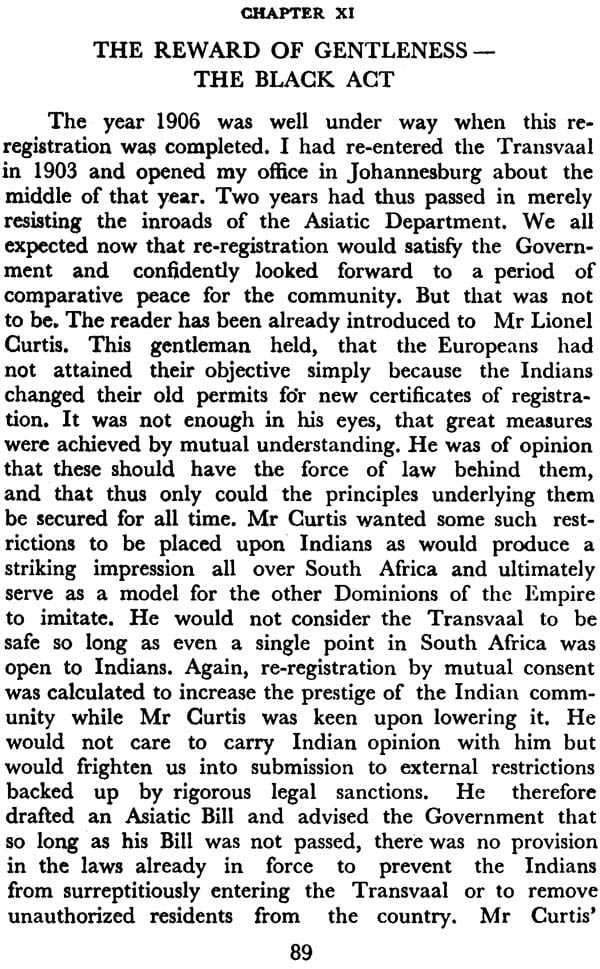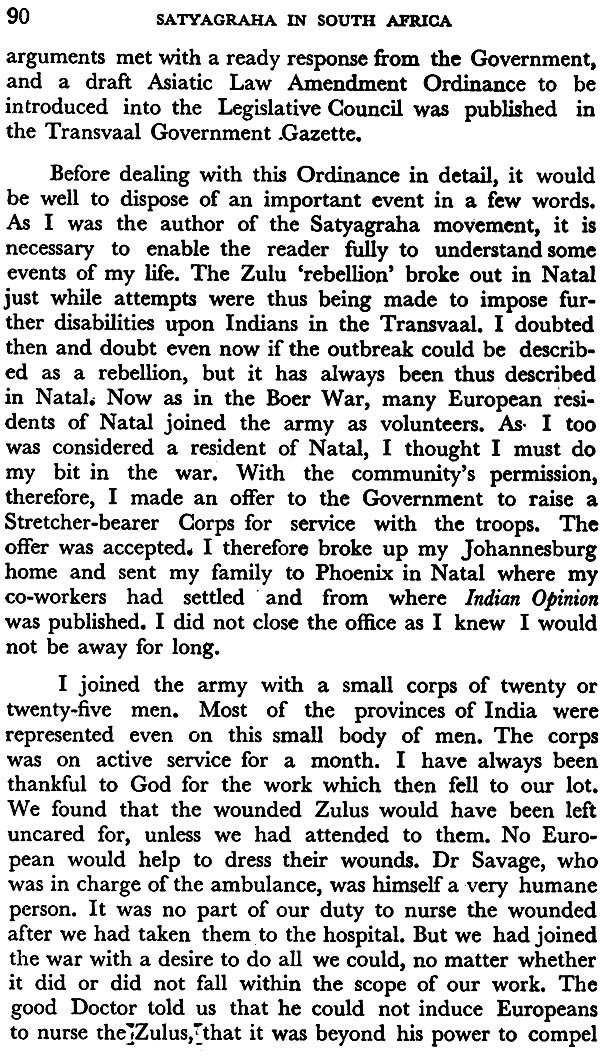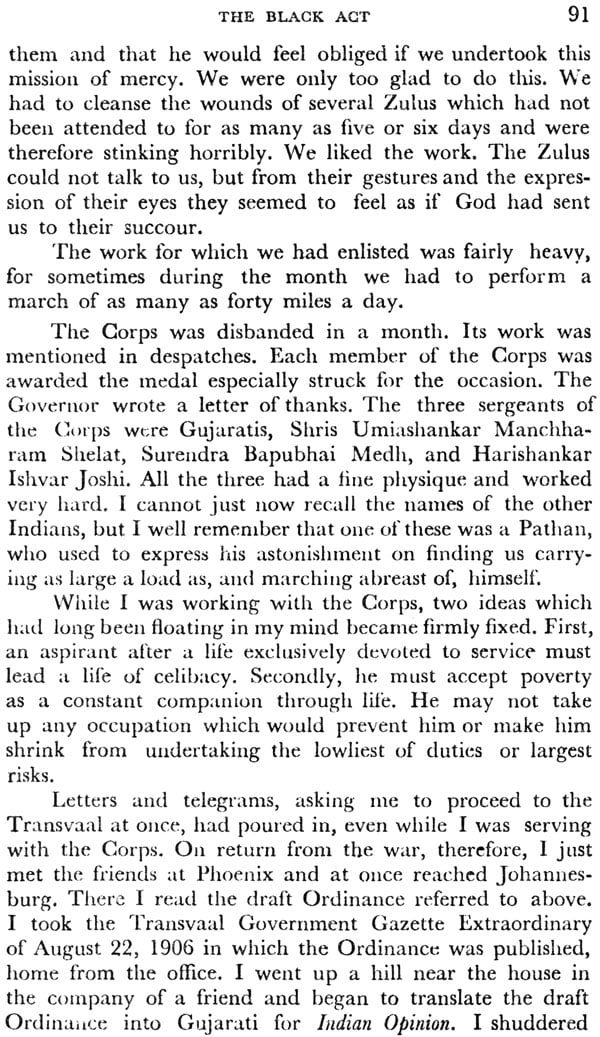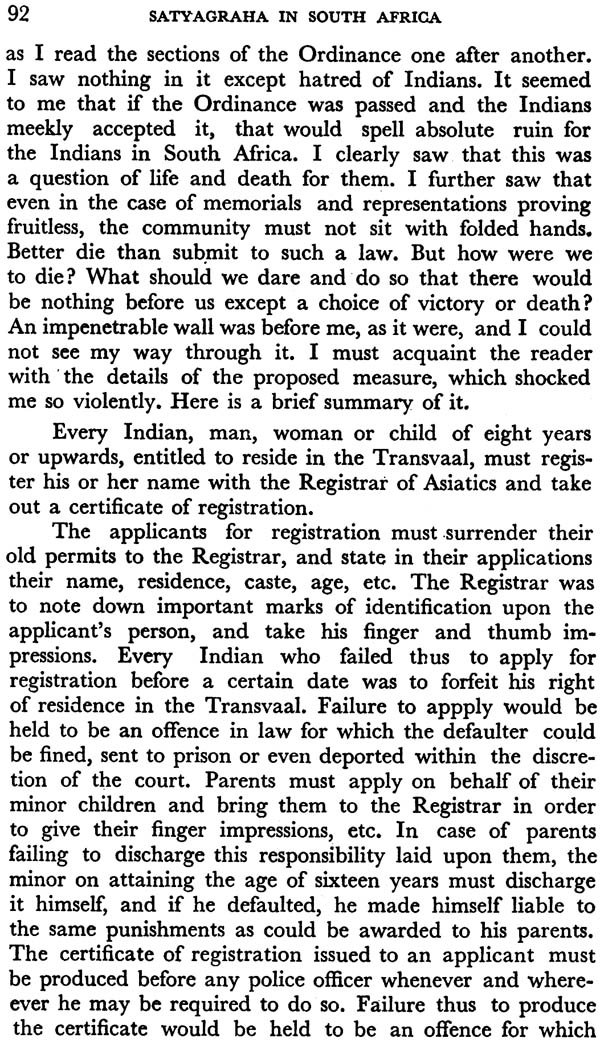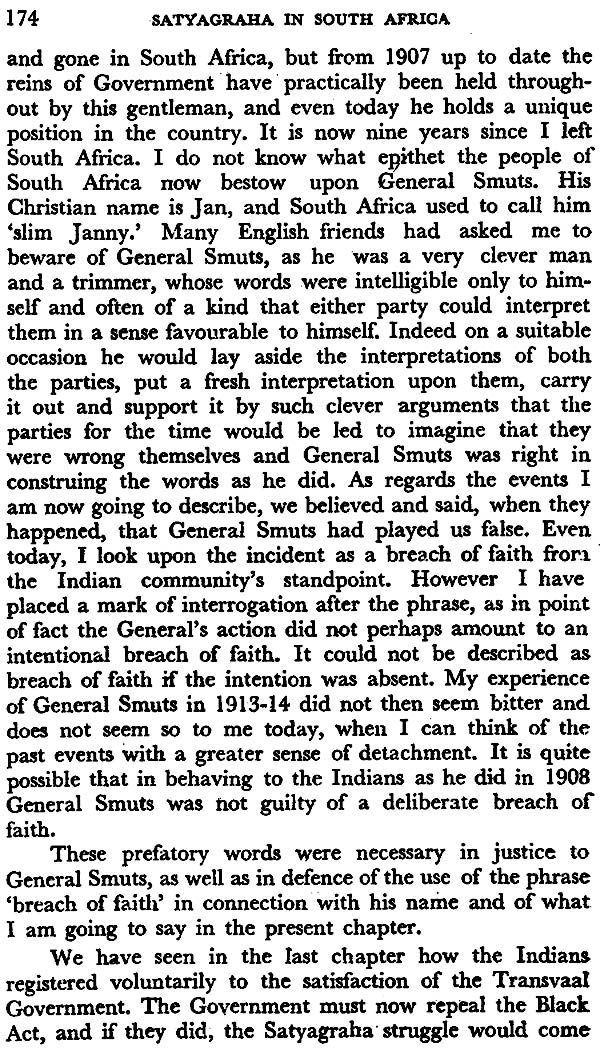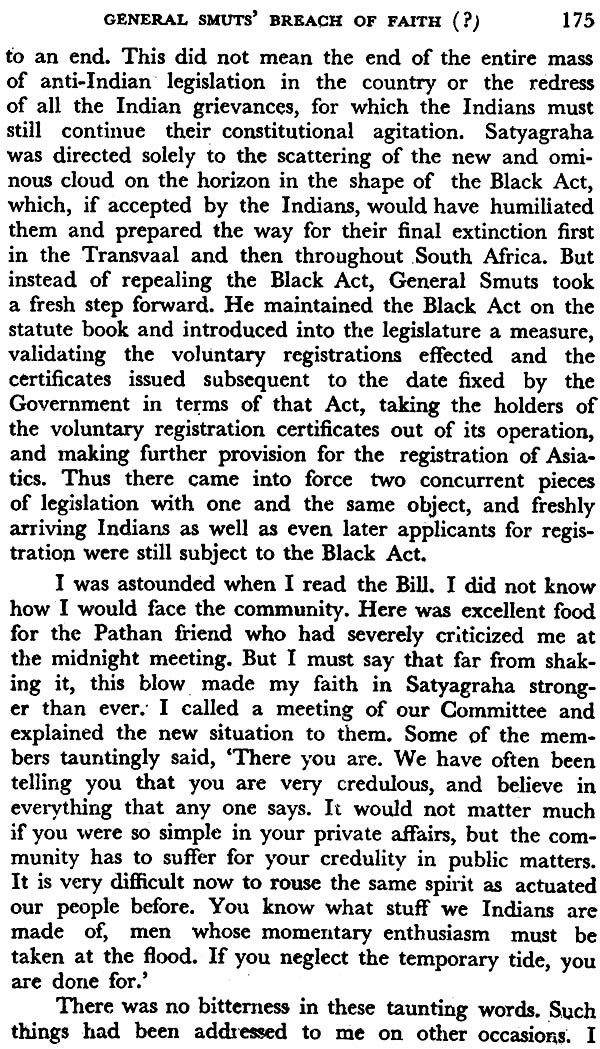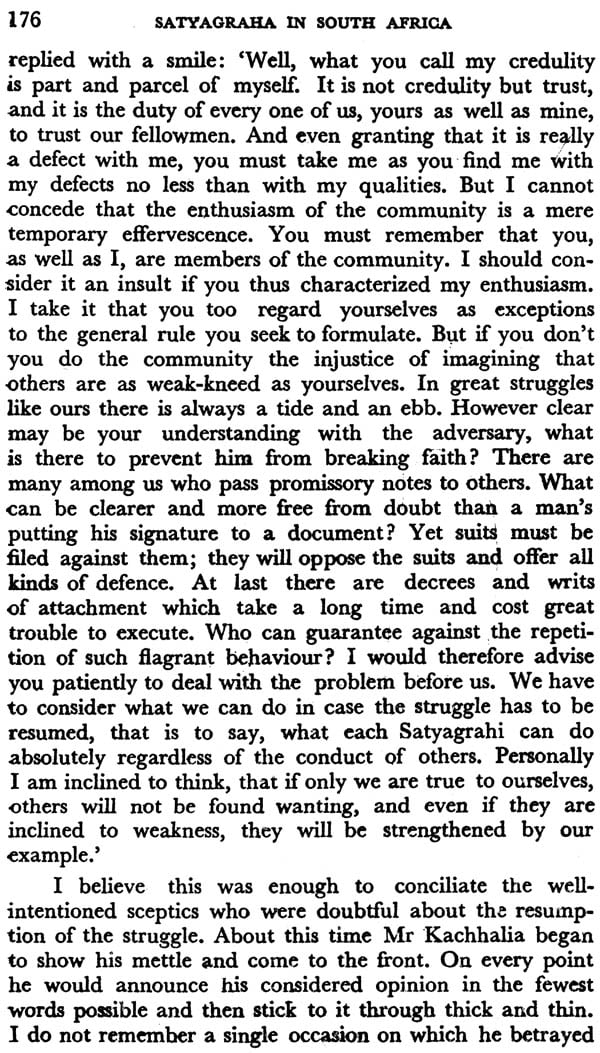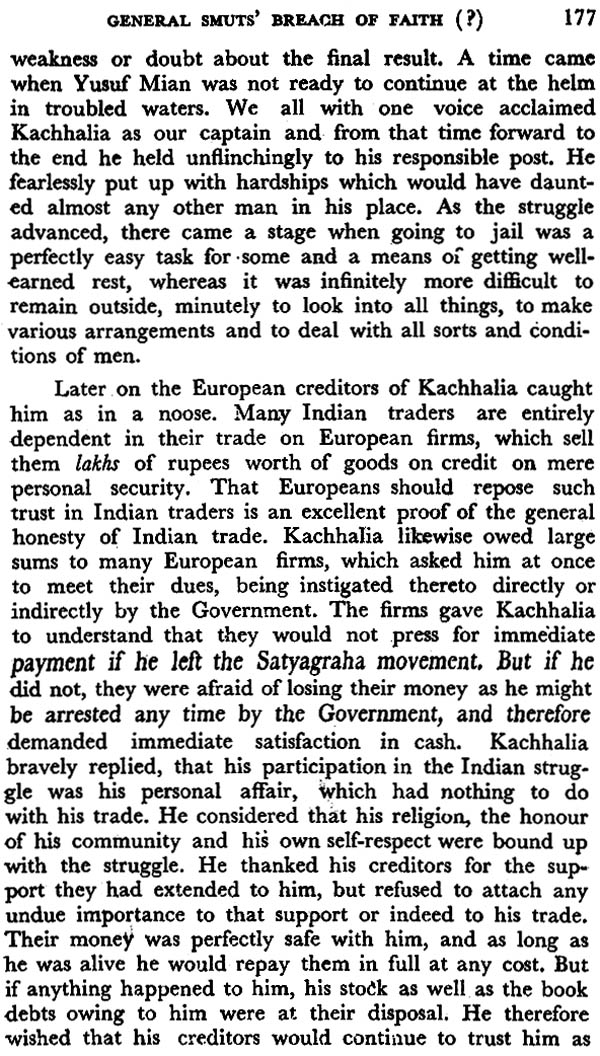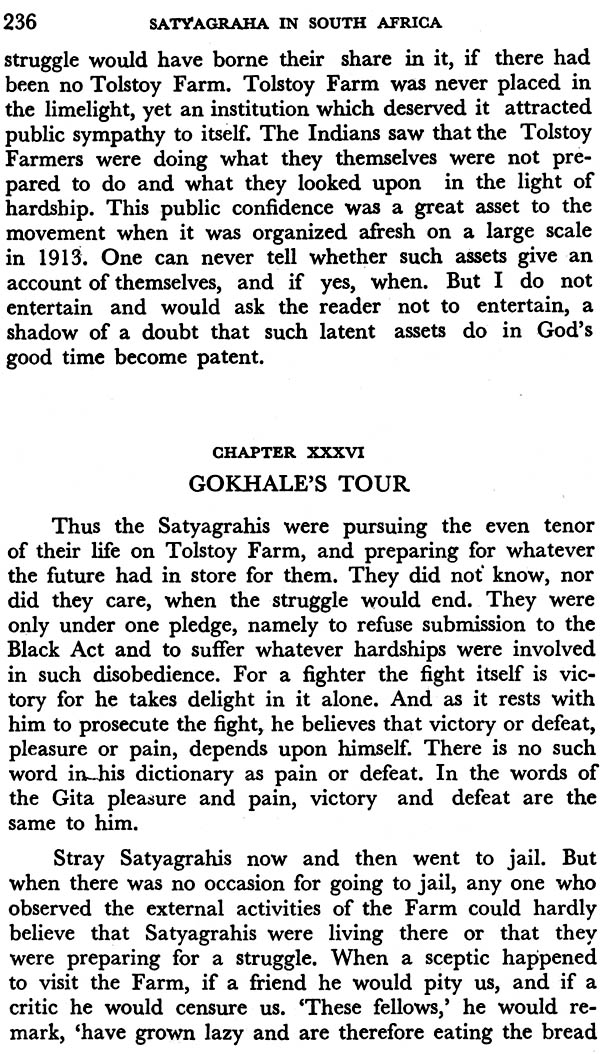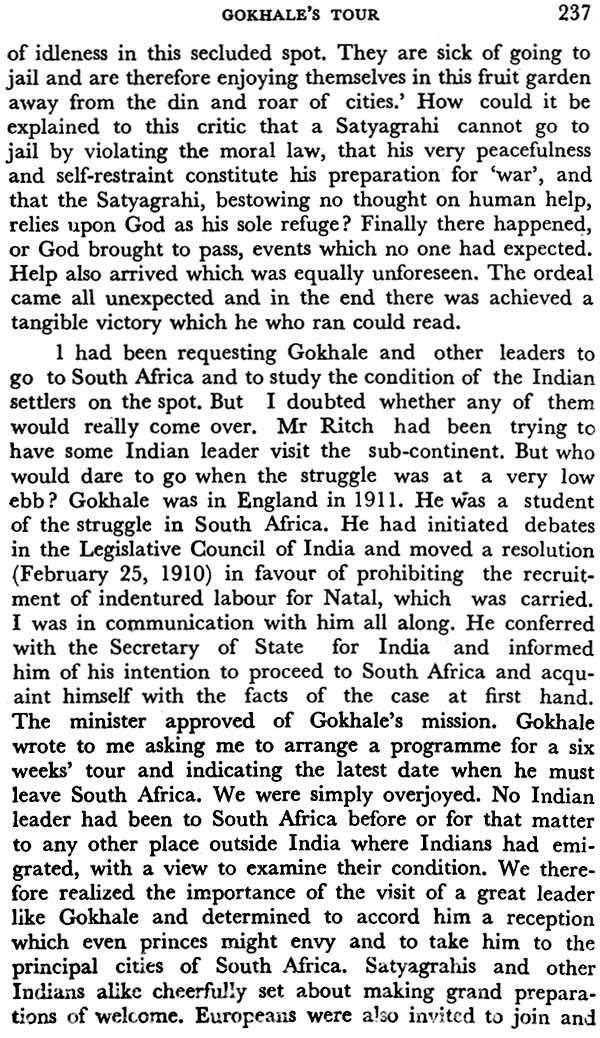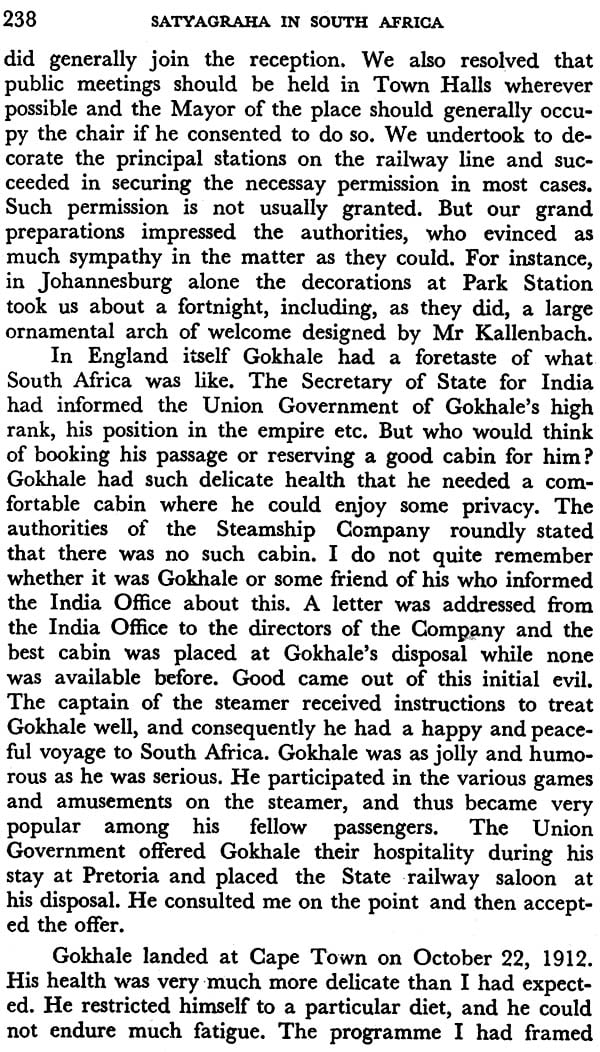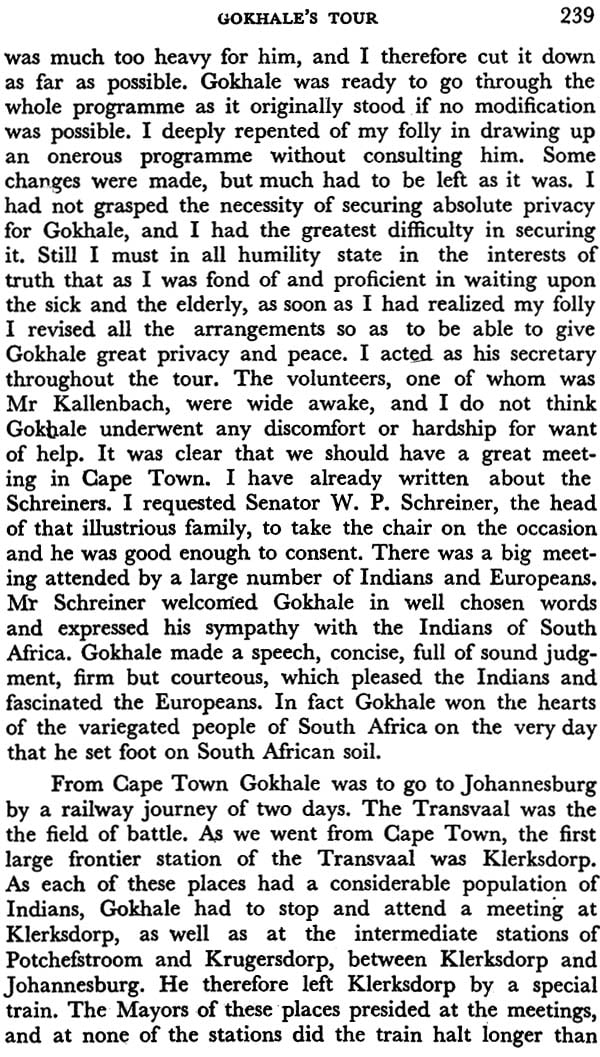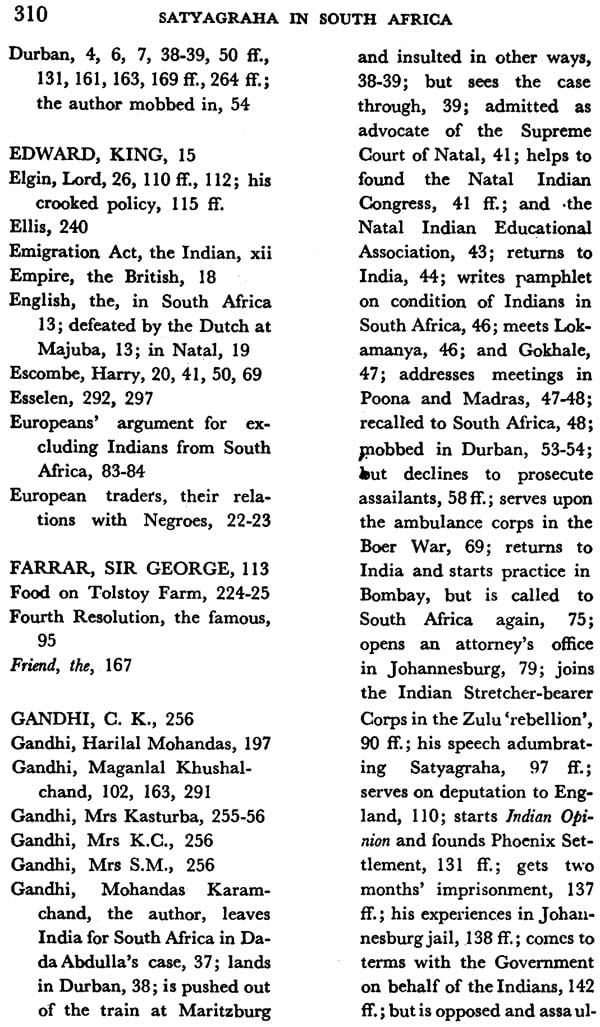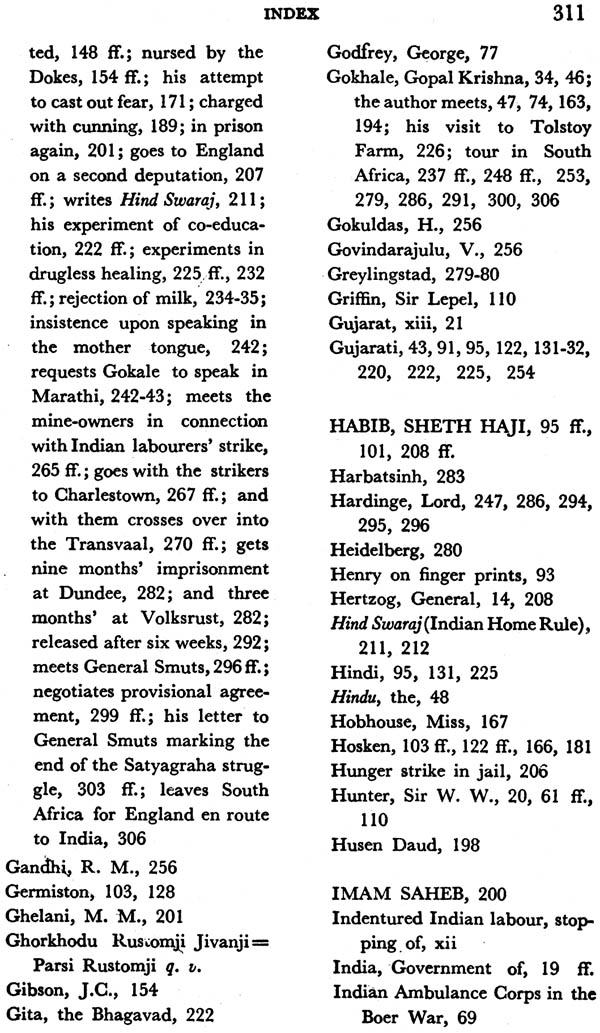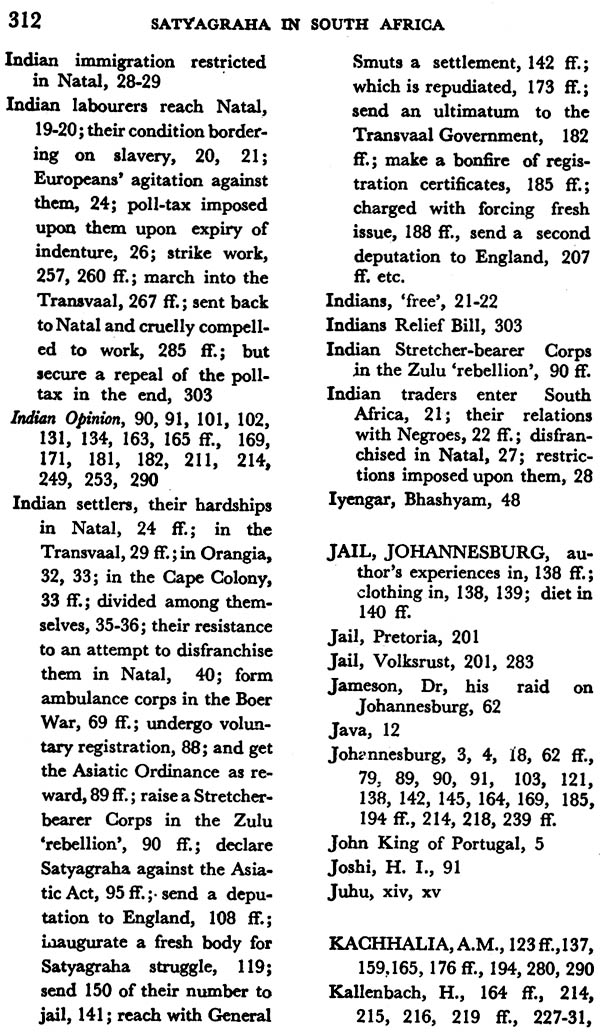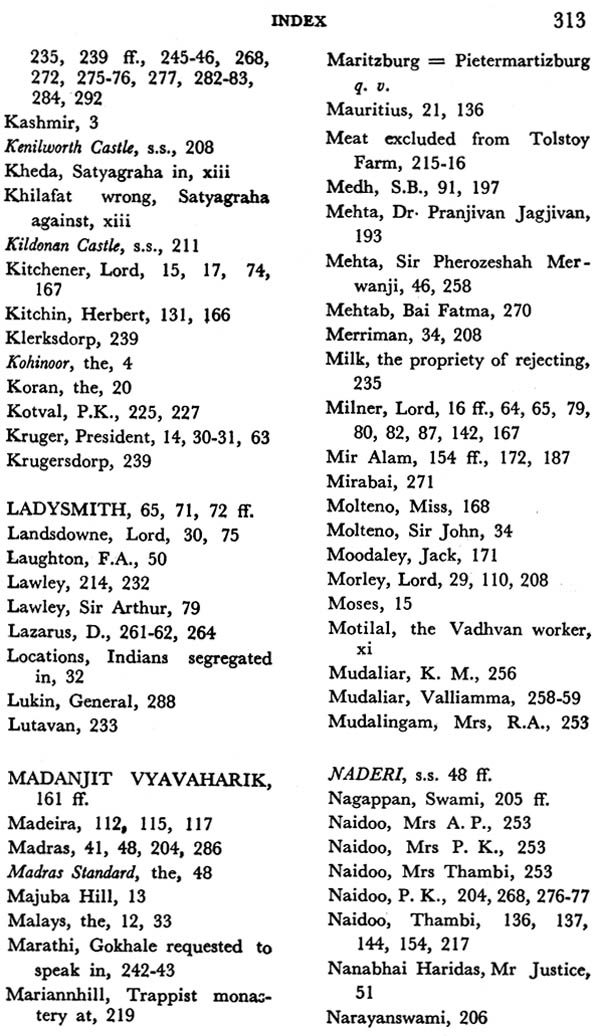
Satyagraha in South Africa
Book Specification
| Item Code: | NAI476 |
| Author: | M.K.Gandhi |
| Publisher: | Navajivan Publishing House |
| Language: | English |
| Edition: | 2008 |
| ISBN: | 8172290411 |
| Pages: | 332 |
| Cover: | Paperback |
| Other Details | 7 inch X 5 inch |
| Weight | 230 gm |
Book Description
Shri Valji Desai's translation has been revised by me, and I can assure the reader that the spirit of the original in Gujarati has been very faithfully kept by the translator. The original chapters were all written by me from memory. They were written partly in the Yeravda jail and partly outside after my premature release. As the translator knew of this fact, he made a diligent study of the file of Indian Opinion and whenever he discovered slips of memory, he has not hesitated to make the necessary corrections. The reader will share my pleasure that in no relevant or material particular has there been any slip. I need hardly mention that those who are following the weekly chapters of My Experiments with Truth cannot afford to miss these chapters on Satyagraha, if they would follow in all its detail the working out of the search after Truth.
The Satyagraha struggle of the Indians in South Africa lasted eight years. The term Satyagrha was invented and employed in connection therewith. I had long entertained a desire to write a history of that struggle myself. Some things only I could write. Only the general who conducts a campaign can know the objective of each particular move. And as this was the first attempt to apply the principle of Satyagraha to politics on a large scale, it is necessary any day that the public should have an idea of its development.
But today Satyagraha has had ample scope in India. Here there has been an inevitable series of struggles beginning with the rather local question of the Viramgam customs.
It was through the instrumentality of Bhai Motilal, the public-spirited good tailor of Vadhvan, that I became interested in the Viramgam question. I had just arrived from England and was proceeding to Saurashtra in the year 1915. I was travelling third class. At Vadhvan station Motilal came up to me with a small party. He gave me some account of the hardships inflicted on the people at Viramgam, and said:
"Please do something to end this trouble. It will be doing an immense service to Saurashtra, the land of your birth."
There was an expression of both compassion and firmness in his eyes.
"Are you ready to go to jail?" I asked.
"We are ready to march to the gallows," was the quick reply.
"Jail will do for me," I said. "But see that you do not leave me in the lurch."
"That only time can show," said Motilal.
I reached Rajkot, obtained detailed information and commenced correspondence with Government. In speeches at Bagasra and elsewhere, I dropped a hint that the people should be ready to offer Satyagraha at Viramgam if necessary. The loyal C. I. D. brought these speeches to the notice of Government. In this they served Government and unintentionally, served the people also. Finally, I had a talk with Lord Chelmsford on the matter. He promised abolition of the customs line and was as good as his word. I know others also tried for this. But I am strongly of opinion that the imminent possibility of Satyagraha was the chief factor in obtaining the desired redress.
Then came the Indian Emigration Act. Great efforts were put forth to get indenture repealed. There was a considerable public agitation. The Bombay meeting fixed May 31, 1917 as the date from which onwards indentured labour should be stopped. This is not the place for narrating how that particular date came to be selected. A deputation of ladies first waited upon the Viceroy in connection with this. I cannot help mentioning here the name of the high-souled sister, Mrs Jaiji Petit. It was she who may be said to have organized this deputation. Here, too, success came merely through preparedness for Satyagraha. But it is important to remember the distinction that in this case public agitation was also necessary. The stopping of indentured labour was very much more important than the abolition of the Viramgam customs. Lord Chelmsford committed a series of blunders beginning with the passing of the Rowlatt Act. Still, I think, he was a wise ruler. But what Viceroy can escape for long the influence of the permanent officials of the Civil Service?
The third in order came the Champaran struggle, of which Rajendra Babu has written a detailed history. Here Satyagraha had actually to be offered. Mere preparedness for it did not suffice, as powerful vested interests were arrayed in opposition. The peace maintained by the people of Champaran deserves to be placed on record. I can bear witness to the perfect non-violence of the leaders in thought, word and deed. Hence it was that this age-long abuse came to an end in six months.
The fourth struggle was that of the mill-hands of Ahmedabad. Gujarat is perfectly familiar with its history. How peaceful the labourers were! As for the leaders, there can hardly be anything for me to say. Still I hold the victory in this case was not quite pure, as the fast I had to observe in order to sustain. the labourers in their determination exercised indirect pressure upon the mill- owners. The fast was bound to -influence them, as I enjoyed friendly relations with them. Still the moral of the fight is clear. If the labourers carry on their struggle peacefully, they must succeed and also win the hearts of their masters. They have not won their masters' hearts, as they were not innocent in thought, word and deed. They were non-violent in deed, which is certainly to their credit.
The fifth was the Kheda struggle. I cannot say that in this case all the local leaders of Satyagraha parties adhered to the pure truth. Peace was certainly maintained. The non-violence of the peasantry, however, was only superficial, like that of the mill-hands. So we came out of the struggle with bare honour. However there was a great awakening among the people. But Kheda had not fully grasped the lesson of non-violence; the mill-hands had not understood the true meaning of peace. The people had therefore to suffer. At the time of the Rowlatt Act Satyagraha, I had to confess my Himalayan blunder, to fast myself and invite others to do so.
The sixth was in connection with the Rowlatt Act. Therein our inherent shortcomings came to the surface. But the original foundation was well and truly laid. We admitted all our shortcomings and did penance for them. The Rowlatt Act was a dead letter even when it was promulgated, and that black act was finally even repealed. This struggle taught us a great lesson.
The seventh was the struggle to right the Khilafat and the Punjab wrongs and to win Swaraj. It is still going on. And my confidence is unshaken, that if a single Satyagrahi holds out to the end, victory is absolutely certain.
But the present fight is epic in character. I have already described our course of unconscious preparation for it. When I took up the Viramgam question, little did I know that other fights were in store. And even about Viramgam I knew nothing when I was in South Africa. That is the beauty of Satyagraha. It comes up to oneself; one has not to go out in search for it. This is a virtue inherent in the principle itself. A dharma-yuddha, in which there are no secrets to be guarded, no scope for cunning and no place for untruth, comes unsought; and a man of religion is ever ready for it. A struggle which has to be previously planned is not a righteous struggle. In a righteous struggle God Himself plans campaigns and conducts battles. A dharma-yuddha can be waged only in the name of God, arid it is only when the Satyagrahi feels quite helpless, is apparently on his last legs and finds utter darkness all around him, that God comes to the rescue. God helps when one feels oneself humbler than the very dust under one's feet. Only to the weak and helpless is divine succour vouchsafed.
We are yet to realize this truth, and so I think the history of Satyagraha in South Africa will be helpful to us.
The reader will note South African parallels for all our experiences in the present struggle to date. He will also see from this history that there is so far no ground whatever for despair in the fight that is going on. The only condition of victory is a tenacious adherence to our programme.
I am writing this preface at Juhu. I wrote the first thirty chapters of the history in Yeravda jail. Shri Indulal Yajnik was good enough to write to my dictation. The subsequent chapters I hope to write hereafter. I had no books of reference in jail. Nor do I propose to get them here. I have neither the time nor the inclination to write a regular detailed history. My only object in writing this book is that it may be helpful in our present struggle, and serve as a guide to any regular historian who may arise in the future. Although I am writing without books of reference at hand, I must ask the reader not to imagine that any single item in this volume is inaccurate or that there is the least exaggeration at any point.
| Chapter | Page | |
| Foreword | vii | |
| Translator's Note | viii | |
| Preface | xi | |
| I | Geography | 3 |
| II | History | 7 |
| III | Indians Enter South Africa | 19 |
| IV | A Review Of The Grievances (Natal) | 24 |
| V | A Review Of The Grievances(The Transvaal and other colonies) | 29 |
| VI | A Review Of The Early Struggle | 35 |
| VII | A Review Of The Early Struggle (continued) | 45 |
| VIII | A Review Of The Early Struggle (concluded)- The Work in England | 60 |
| IX | The Boer War | 62 |
| X | After The War | 74 |
| XI | The Reward Of Gentleness- The Black Act | 89 |
| XII | The Advent Of Satyagraha | 95 |
| XIII | Satyagraha v. Passive Resistance | 103 |
| XIV | Deputation To England | 108 |
| XV | Crooked Policy | 115 |
| XVI | Ahmad Muhammad Kachhalia | 118 |
| XVII | A Rift In The Lute | 125 |
| XVIII | The First Satyagrahi Prisoner | 128 |
| XIX | Indian Opinion' | 131 |
| XX | A Series Of Arrests | 134 |
| XXI | The First Sattlement | 142 |
| XXII | Opposition And Assuault | 145 |
| XXIII | European Support | 160 |
| XXIV | Further Internal Difficulties | 169 |
| XXV | General Smuts' Breach Of Faith(?) | 173 |
| XXVI | Resumption Of The Struggle | 182 |
| XXVII | A Bonefire Of Certificates | 185 |
| XXVIII | Charge Of Forcing Fresh Issue | 188 |
| XXIX | Sorabji Shapurhi Adajania | 192 |
| XXX | Sheth Daud Mahomed Etc. Enter The Struggle | 197 |
| XXXI | Deportations | 202 |
| XXXII | A Second Deputations | 207 |
| XXXIII | Tolstoy Farm-I | 212 |
| XXXIV | Tolstoy Farm-II | 215 |
| XXXV | Tolstoy Farm -III | 221 |
| XXXVI | Gokhle's Tour | 236 |
| XXXVII | Gokhle's Tour(concluded) | 243 |
| XXXVIII | Breach Of Pledge | 247 |
| XXXIX | When Marriage Is Not A Marriage | 251 |
| XL | Women In Jail | 257 |
| XLI | A Stream Of Labourers | 260 |
| XLII | The Conference And After | 265 |
| XLIII | Crossing The Border | 270 |
| XLIV | The Great March | 274 |
| XLV | All In Prison | 278 |
| XLVI | The Test | 285 |
| XLVII | The Beginning Of The End | 290 |
| XLVIII | The Provisional Settlement | 296 |
| XLIX | Letters Exchanged | 299 |
| L | The End Of The Struggle | 303 |
| Conclusion | 306 | |
| Index | 308 |

